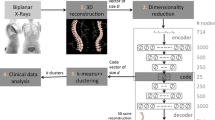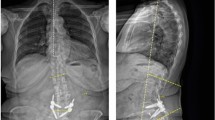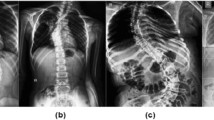Abstract
Purpose
AI algorithms have shown promise in medical image analysis. Previous studies of ASD clusters have analyzed alignment metrics—this study sought to complement these efforts by analyzing images of sagittal anatomical spinopelvic landmarks. We hypothesized that an AI algorithm would cluster preoperative lateral radiographs into groups with distinct morphology.
Methods
This was a retrospective review of a multicenter, prospectively collected database of adult spinal deformity. A total of 915 patients with adult spinal deformity and preoperative lateral radiographs were included. A 2 × 3, self-organizing map—a form of artificial neural network frequently employed in unsupervised classification tasks—was developed. The mean spine shape was plotted for each of the six clusters. Alignment, surgical characteristics, and outcomes were compared.
Results
Qualitatively, clusters C and D exhibited only mild sagittal plane deformity. Clusters B, E, and F, however, exhibited marked positive sagittal balance and loss of lumbar lordosis. Cluster A had mixed characteristics, likely representing compensated deformity. Patients in clusters B, E, and F disproportionately underwent 3-CO. PJK and PJF were particularly prevalent among clusters A and E. Among clusters B and F, patients who experienced PJK had significantly greater positive sagittal balance than those who did not.
Conclusions
This study clustered preoperative lateral radiographs of ASD patients into groups with highly distinct overall spinal morphology and association with sagittal alignment parameters, baseline HRQOL, and surgical characteristics. The relationship between SVA and PJK differed by cluster. This study represents significant progress toward incorporation of computer vision into clinically relevant classification systems in adult spinal deformity.
Level of Evidence IV
Diagnostic: individual cross-sectional studies with the consistently applied reference standard and blinding.







Similar content being viewed by others
Data availability
The data from this study was obtained from the International Spine Study Group.
Code availability
Code for this study may be available upon request.
References
Schwab FJ, Blondel B, Bess S, Hostin R, Shaffrey CI, Smith JS, Boachie-Adjei O, Burton DC, Akbarnia BA, Mundis GM (2013) Radiographical spinopelvic parameters and disability in the setting of adult spinal deformity: a prospective multicenter analysis. Spine 38(13):E803–E812
Pellisé F, Vila-Casademunt A, Ferrer M, Domingo-Sàbat M, Bagó J, Pérez-Grueso FJS, Alanay A, Mannion AF, Acaroglu E, European Spine Study Group E (2015) Impact on health related quality of life of adult spinal deformity (ASD) compared with other chronic conditions. Eur Spine J 24(1):3–11. https://doi.org/10.1007/s00586-014-3542-1
Ames CP, Scheer JK, Lafage V, Smith JS, Bess S, Berven SH, Mundis GM, Sethi RK, Deinlein DA, Coe JD (2016) Adult spinal deformity: epidemiology, health impact, evaluation, and management. Spine deformity 4(4):310–322
Smith JS, Klineberg E, Schwab F, Shaffrey CI, Moal B, Ames CP, Hostin R, Fu K-MG, Burton D, Akbarnia B (2013) Change in classification grade by the srs-schwab adult spinal deformity classification predicts impact on health-related quality of life measures: prospective analysis of operative and nonoperative treatment. Spine 38(19):1663–1671
Schwab F, Ungar B, Blondel B, Buchowski J, Coe J, Deinlein D, DeWald C, Mehdian H, Shaffrey C, Tribus C (2012) Scoliosis Research Society—Schwab adult spinal deformity classification: a validation study. Spine 37(12):1077–1082
Terran J, Schwab F, Shaffrey CI, Smith JS, Devos P, Ames CP, Fu K-MG, Burton D, Hostin R, Klineberg E (2013) The SRS-Schwab adult spinal deformity classification: assessment and clinical correlations based on a prospective operative and nonoperative cohort. Neurosurgery 73(4):559–568
Horng M-H, Kuok C-P, Fu M-J, Lin C-J, Sun Y-N (2019) Cobb angle measurement of spine from X-ray images using convolutional neural network. Computational and mathematical methods in medicine 2019
Wu H, Bailey C, Rasoulinejad P, Li S (2018) Automated comprehensive adolescent idiopathic scoliosis assessment using MVC-Net. Med Image Anal 48:1–11. https://doi.org/10.1016/j.media.2018.05.005
Zhang J, Li H, Lv L, Zhang Y (2017) Computer-aided cobb measurement based on automatic detection of vertebral slopes using deep neural network. Int J Biomed Imaging 2017:9083916. https://doi.org/10.1155/2017/9083916
Aubert B, Vidal P, Parent S, Cresson T, Vazquez C, De (2017) Guise J Convolutional neural network and in-painting techniques for the automatic assessment of scoliotic spine surgery from biplanar radiographs. International conference on medical image computing and computer-assisted intervention. Springer, pp 691–699
Choi R, Watanabe K, Jinguji H, Fujita N, Ogura Y, Demura S, Kotani T, Wada K, Miyazaki M, SHIGEMATSU H, (2017) CNN-based spine and Cobb angle estimator using moire images. IIEEJ Trans Image Electron V Comput 5(2):135–144
Watanabe K, Aoki Y, Matsumoto M (2019) An application of artificial intelligence to diagnostic imaging of spine disease: estimating spinal alignment from moire images. Neurospine 16(4):697–702. https://doi.org/10.14245/ns.1938426.213
Jaremko JL, Poncet P, Ronsky J, Harder J, Dansereau J, Labelle H, Zernicke RF (2002) Genetic algorithm-neural network estimation of cobb angle from torso asymmetry in scoliosis. J Biomech Eng 124(5):496–503. https://doi.org/10.1115/1.1503375
Lin H (2008) Identification of spinal deformity classification with total curvature analysis and artificial neural network. IEEE Trans Biomed Eng 55(1):376–382. https://doi.org/10.1109/tbme.2007.894831
Galbusera F, Niemeyer F, Wilke HJ, Bassani T, Casaroli G, Anania C, Costa F, Brayda-Bruno M, Sconfienza LM (2019) Fully automated radiological analysis of spinal disorders and deformities: a deep learning approach. Eur Spine J 28(5):951–960. https://doi.org/10.1007/s00586-019-05944-z
Hekler A, Utikal JS, Enk AH, Berking C, Klode J, Schadendorf D, Jansen P, Franklin C, Holland-Letz T, Krahl D (2019) Pathologist-level classification of histopathological melanoma images with deep neural networks. Eur J Cancer 115:79–83
Wang H, Roa AC, Basavanhally AN, Gilmore HL, Shih N, Feldman M, Tomaszewski J, Gonzalez F, Madabhushi A (2014) Mitosis detection in breast cancer pathology images by combining handcrafted and convolutional neural network features. J Med Imaging 1(3):034003
Zhang Z, Chen P, McGough M, Xing F, Wang C, Bui M, Xie Y, Sapkota M, Cui L, Dhillon J (2019) Pathologist-level interpretable whole-slide cancer diagnosis with deep learning. Nat Mach Intell 1(5):236–245
Rajpurkar P, Irvin J, Zhu K, Yang B, Mehta H, Duan T, Ding D, Bagul A, Langlotz C, Shpanskaya K (2017) Chexnet: Radiologist-level pneumonia detection on chest x-rays with deep learning. arXiv preprint
Lakhani P, Sundaram B (2017) Deep learning at chest radiography: automated classification of pulmonary tuberculosis by using convolutional neural networks. Radiology 284(2):574–582
Olczak J, Fahlberg N, Maki A, Razavian AS, Jilert A, Stark A, Sköldenberg O, Gordon M (2017) Artificial intelligence for analyzing orthopedic trauma radiographs: deep learning algorithms—are they on par with humans for diagnosing fractures? Acta Orthop 88(6):581–586
Urakawa T, Tanaka Y, Goto S, Matsuzawa H, Watanabe K, Endo N (2019) Detecting intertrochanteric hip fractures with orthopedist-level accuracy using a deep convolutional neural network. Skeletal Radiol 48(2):239–244
Gan K, Xu D, Lin Y, Shen Y, Zhang T, Hu K, Zhou K, Bi M, Pan L, Wu W (2019) Artificial intelligence detection of distal radius fractures: a comparison between the convolutional neural network and professional assessments. Acta Orthop 90(4):394–400
Cheng C-T, Ho T-Y, Lee T-Y, Chang C-C, Chou C-C, Chen C-C, Chung I-F, Liao C-H (2019) Application of a deep learning algorithm for detection and visualization of hip fractures on plain pelvic radiographs. Eur Radiol 29(10):5469–5477
Couteaux V, Si-Mohamed S, Nempont O, Lefevre T, Popoff A, Pizaine G, Villain N, Bloch I, Cotten A, Boussel L (2019) Automatic knee meniscus tear detection and orientation classification with Mask-RCNN. Diagn Interv Imaging 100(4):235–242. https://doi.org/10.1016/j.diii.2019.03.002
Norman B, Pedoia V, Noworolski A, Link TM, Majumdar S (2019) Applying densely connected convolutional neural networks for staging osteoarthritis severity from plain radiographs. J Digit Imaging 32(3):471–477
Kohonen T (1997) Exploration of very large databases by self-organizing maps. In: Proceedings of international conference on neural networks (icnn'97). IEEE 1:1-16
Mezghani N, Phan P, Mitiche A, Labelle H, de Guise JA (2012) A Kohonen neural network description of scoliosis fused regions and their corresponding Lenke classification. Int J Comput Assist Radiol Surg 7(2):257–264. https://doi.org/10.1007/s11548-011-0667-0
Phan P, Mezghani N, Wai EK, de Guise J, Labelle H (2013) Artificial neural networks assessing adolescent idiopathic scoliosis: comparison with lenke classification. Spine J 13(11):1527–1533. https://doi.org/10.1016/j.spinee.2013.07.449
Copay AG, Glassman SD, Subach BR, Berven S, Schuler TC, Carreon LY (2008) Minimum clinically important difference in lumbar spine surgery patients: a choice of methods using the oswestry disability index, medical outcomes study questionnaire short form 36, and pain scales. Spine J 8(6):968–974
Michelson JD (2019) CORR Insights®: what are the applications and limitations of artificial intelligence for fracture detection and classification in orthopaedic trauma imaging A systematic review. Clinical Orthopaedics and Related Research® 477(11):2492–2494
Stead WW (2018) Clinical implications and challenges of artificial intelligence and deep learning. JAMA 320(11):1107–1108. https://doi.org/10.1001/jama.2018.11029
Roussouly P, Nnadi C (2010) Sagittal plane deformity: an overview of interpretation and management. Eur Spine J 19(11):1824–1836
Roussouly P, Gollogly S, Berthonnaud E, Dimnet J (2005) Classification of the normal variation in the sagittal alignment of the human lumbar spine and pelvis in the standing position. Spine 30(3):346–353
Funding
This study was supported by the ISSG foundation.
Author information
Authors and Affiliations
Consortia
Corresponding author
Ethics declarations
Conflict of interest
Wesley Durand has no potential conflicts of interest. Renaud Lafage has Stock ownership in Nemaris Inc. David K Hamilton has no potential conflicts of interest. Peter Passias has Consulting fees from Medicrea and SpineWave, Speaking/teaching arrangements from Zimmer Biomet, Scientific advisory board at Allosource, and Grants from Cervical Spine Research Society. Han Jo Kim has Fellowship support from AOSpine, Research support from CSRS and ISSGF, and Royalties from K2M and Zimmer Biomet. Themistocles Protopsaltis has Consulting fees from Globus, Medicrea, Innovasis, K2M, and NuVasive. Virginie Lafage has Stock ownership in Nemaris, Inc., Consulting fees for Globus, Speaking/teaching arrangements for DePuy Spine, K2M, and Board of directors for Nemaris, Inc. Justin S Smith has Grants from DePuy Synthes, Royalties from Zimmer Biomet, Stock ownership in Alphatec, Consulting fees from Zimmer Biomet, Nuvasive, Cerapedics and AllSource, and Fellowship support from AOSpine and NREF. Christopher Shaffrey has Royalties from Medtronic, Nuvasive and Zimmer Biomet, Stock ownership in Nuvasive, Consulting fees for Medtronic, and Fellowship support from NREF and AO. Munish Gupta has Royalties from DePuy and Innomed, Stock ownership in J&J, P&G and Perform Biologics, Consulting for DePuy and Medtronic, Trips/travel for Alphatec and Scoliosis Research Society, Scientific advisory board for DePuy and Medtronic, and Fellowship support from OMeGA and AOSpine. Michael P. Kelly has Fellowship support from AOSpine, and Research support from DePuy Synthes. Eric Klineberg has Consulting fees from DePuy Synthes, Stryker and Medicrea, Speaking/teaching arrangements from AOSpine and K2M, and Fellowship support from AOSpine. Frank Schwab has Royalties from MSD and K2M, Stock ownership in Nemaris, Inc., Consulting fees from Zimmer Biomet, Globus Medical, MSD, K2M and Medicrea, Speaking/teaching arrangements from Zimmer Biomet, MSD, Globus Medical and K2M, and Board of directors for Nemaris, Inc. Jeffrey Gum has Royalties from Acuity, Private Investments in Cingulate, Consulting from Medtronic, Acuity, K2M, NuVasive and Mazor, Speaking or teaching arrangements with Medtronic, Trips/Travel from Broadwater, Scientific Advisory Board with Medtronic and K2M, and Research Support from Pfizer, Intellirod, Texas Scottish Rite and SRS. Gregory Mundis has Royalties from Nuvasive and K2M, Stock Ownership in NuVasive and Viseon, Private Investments in Baker and Eastlack Venture, Consulting with NuVasive, K2M, Allosource, Viseon, SeaSpine, Speaking and teaching arrangements with Nuvasive, Board of Directors on Global Spine Outreach, Society of Lateral Access Surgery and San Diego Spine Foundation, Scientific Advisory Board with SeaSpine and AlloSource, Research Support with ISSGF, and Fellowship Support from NuVasive and SeaSpine. Robert Eastlack has Royalties from Globus Medical, NuTech, SeaSpine and Aesuculap, Stock Ownership from Nuvasive, Spine Innovations, Invuity, Alphatec and SeaSpine, Private Investments in Top Doctors Labs, SeaSpine and Nocimed, Consulting from K2M, Titan, SeaSpine, NuVasive, Aesculap, SI-BONE and Baxter, Board of Directors with SDSF, InjureFree, Nocimed, SOLAS, Spine Innovations and Matrisys, Scientific Advisory Board with ClearView, Top Doctors Labs and Aesculap, Research Support with NuVasive, Grants from Scripps Clinic Medical Grant, and Fellowship Support from SeaSpine and NuVasive. Khaled Kebaish has Royalties from DePuy Synthes, Consulting from SpineCraft, and Speaking or teaching arrangements from K2M. Alex Soroceanu has support from ISSGF. Richard Hostin has Consulting from DePuy. Doug Burton has Royalties from DePuy Spine, Consulting for DePuy Spine, and Board of directors for ISSGF, SRS, and University of Kansas Physicians, and Research support from DePuy Spine, Bioventus and Pfizer. Shay Bess has Grants from K2, DePuy Spine and Nuvasive, Royalties from K2M, Consulting for K2M, Scientific advisory board for EOS and MISONIX, and Grants from ISSGF. Christopher Ames has Royalties from Stryker, Zimmer Biomet, DePuy Synthes, Nuvasive, Next Orthosurgical, K2M and Medicrea, Consulting from DePuy Synthes, Medtronic, Medicrea and K2M, Research support from Titan Spine, DePuy Synthes and ISSG, and Grants from SRS. Robert Hart has Royalties from Seaspine and DSS, Consulting from Globus, and Grants from ISSGF. Alan H Daniels has Consulting fees from Stryker, Orthofix, Spineart and EOS, Research support from Southern Spine, and Fellowship support from Orthofix.
Ethical approval
IRB approval at each participating site was obtained.
Informed consent
Patient consent was obtained.
Additional information
Publisher's Note
Springer Nature remains neutral with regard to jurisdictional claims in published maps and institutional affiliations.
Supplementary Information
Below is the link to the electronic supplementary material.
Rights and permissions
About this article
Cite this article
Durand, W.M., Lafage, R., Hamilton, D.K. et al. Artificial intelligence clustering of adult spinal deformity sagittal plane morphology predicts surgical characteristics, alignment, and outcomes. Eur Spine J 30, 2157–2166 (2021). https://doi.org/10.1007/s00586-021-06799-z
Received:
Revised:
Accepted:
Published:
Issue Date:
DOI: https://doi.org/10.1007/s00586-021-06799-z




